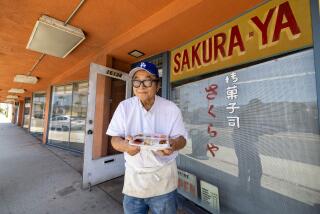Japanâs police on alert in wake of reported yakuza group split
Reporting from Tokyo â Japanâs largest yakuza group, or crime syndicate, the Yamaguchi-gumi, marks its 100th year in business in 2015, but the groupâs future looks to be in doubt following two meetings this week in the western city of Kobe that apparently have split the organization in two.
Police nationwide have gone on full alert, fearing that the fissure will spark a bloody gang war, as a previous factional divide did in 1984. More than 100 police officers were on duty in the area around the Yamaguchi-gumi headquarters in Kobe, according to a senior detective in the Hyogo Prefectural Police Department, as well as multiple Japanese media outlets, including the Sankei newspaper.
Sources with the National Police Agency and Hyogo police expressed concern that the divide may herald further problems. National broadcaster NHK reported Saturday that police were attempting to confirm reports that the Yamaguchi-gumi headquarters would be moved to Nagoya from its present location in Kobe, the capital of Hyogo.
The senior detective, who requested anonymity because he was not authorized to speak to the media, said: âThe split may result in a free- for-all in the yakuza world as various factions of the Yamaguchi-gumi and other organized crime groups attempt to seize power and create new alliances in the transition period.â
The Yamaguchi-gumi had more than 23,400 members at the end of 2014 according to the National Police Agency, making the organization the most powerful of 21 such groups on the Japanese governmentâs watch list.
In Japan, groups like the Yamaguchi-gumi exist as semi-legal entities engaging in legal as well as illegal businesses. Some run corporations, real estate agencies, and construction companies while also keeping their hand in traditional illicit activities such as blackmail, extortion and fraud.
They also supply labor to nuclear power plants, including the Fukushima nuclear power plant disaster cleanup after the devastating 2011 earthquake and tsunami, according to the National Police Agency and other reports.
The yakuza are tolerated to some degree and even admired in some circles, with two monthly yakuza fan magazines in circulation.
Atsushi Mizoguchi, a Japanese author who has penned two books about the Yamaguchi-gumi, told NHK that one faction of the group, the Yamaken-gumi, which has about 2,000 members, has long been unhappy with the division of prime leadership posts.
âThe organization has been essentially divided between two main groups and the opposition became so deep that it finally resulted in the breakup,â he said.
He predicted that the division would not result in the same level of gang violence as in a previous split of the Yamaguchi-gumi in the â80s. But he predicted there would be small skirmishes between the two groups, perhaps continuing for several years.
In January 2006, a Yamaken-gumi member stabbed Mizoguchiâs son in retaliation for an article that the author had written for a weekly magazine; one person was apprehended but the head of the Yamaken-gumi at the time was not prosecuted.
The Yamaguchi-gumi was founded in 1915 as a temporary labor dispatch service by Harukichi Yamaguchi, a former fisherman.
It has grown into an organization so powerful that the U.S. Treasury Department sanctioned several of its top members in December 2013 in a crackdown on transcontinental crime, authorizing freezing of their bank accounts and seizure of their assets.
The Kodo-kai faction was singled out in an April 2105 announcement from the Treasury Department. âAmong other criminal activities, the Kodo-kai has conducted extortion and engaged in bribery on behalf of the Yamaguchi-gumi and has gained prominence in part for its financial muscle,â the agency said.
The administration of Prime Minister Shinzo Abe has been accused of having ties to the Yamaguchi-gumi. Hakubun Shimomura, the minister of education, was the subject of intense scrutiny (link in Japanese) in February and March for receiving political donations from a Yamaguchi-gumi front company and political support from a Yamaguchi-gumi Kodo-kai associate. He returned the donations.
Abe was photographed with a reputed financial consigliere of the group in 2008. He denied any close relations to the man in the photo, which shows the two posing with U.S. politician Mike Huckabee.
The conflict appears to stem from divided loyalty to the current leader of the organization, Kenichi Shinoda, also known as Tsukasa Shinobu. The 73-year-old is affiliated with the Kodo-kai faction and took over the Yamaguchi-gumi in 2005.
He replaced Yoshinori Watanabe, who represented the Yamaken-gumi, the second-most powerful faction in the group. The Yamaguchi-gumi is a pyramidlike organization with 72 directly affiliated gang leaders who head their own crime groups. There has long been inter-factional conflict.
The Yamaken-gumi has been resentful of Tsukasaâs reign, feeling that power was not equally divided and that actions taken by the upper management have resulted in increased police crackdowns.
It was not immediately apparent why the split happened now, but there is speculation that it had to do with Tsukasaâs plans to retire this year. His successor was also expected to be from the Kodo-kai faction.
Police sources say that earlier this month, the Yamaken-gumi united with several other major factions in the Kansai region and split from the organization. Rumors of the breakup began circulating early this month.
The breakaway faction is reportedly planning to establish its own organization with a new name, said police sources, and on Friday the breakaway groups boycotted the meeting at the Kobe headquarters and many of their top bosses were permanently expelled from the organization.
The last major conflict in the Yamaguchi-gumi began in 1984 over a dispute over succession. The gang war that followed resulted in more than 25 deaths and 70 injuries. In 1985, several members of the Yamaguchi-gumi were arrested in Hawaii on charges of trying to smuggle 100 pistols, five machine guns and a rocket launcher into Japan, presumably for use in battle.
The last attempted rebellion was in October 2008. The former crime boss Tadamasa Goto led an insurrection after he was dismissed by the group due to insubordination and revelations of a deal he made with the FBI to acquire a visa to travel to the United States so that he could obtain a liver transplant at UCLA.
The Yamaguchi-gumi then banished 10 yakuza bosses who sided with him and split Gotoâs organization into two groups. But there was no violent outbreak after that split.
Tsukasa has forbidden the sale and the use of drugs and other activities that he deems dishonorable. This has spurred resentment among some members who feel deprived of income revenue, according to reports in the Japanese media and talks with low-ranking members.
As part of the effort to reestablish a modicum of moral rectitude to the organization, he revived the Yamaguchi-gumiâs in-house newspaper and even tacitly approved a website under the title of the Banish Drugs and Purify the Nation League, the yakuza fanzines have said.
The English version of the website casts some light on how the group justifies its existence, claiming that it follows what it calls a âchivalrous path.â Yamaguchi-gumi senior members and law enforcement have acknowledged that they intended for the page to generate positive international publicity for the group in light of pressure on Japan to crack down.
The website notes, âThe actual meaning of this discipline is to fight fearlessly even against the strong for the weak, without thinking of the benefits for own. It is a path of a spiritual discipline for justice.â
The website says another justification for the existence of the yakuza is that they serve as a refuge for people marginalized in Japanese society, and the site contains surprising criticism of the current Japanese government, noting that âAbeâs recent comments suggest that Japan is leaning towards nationalism. Therefore, we are facing the reality that our citizensâ equality is on jeopardy.â
Adelstein is a special correspondent.
More to Read
Sign up for Essential California
The most important California stories and recommendations in your inbox every morning.
You may occasionally receive promotional content from the Los Angeles Times.










